

Zitierweise / cite as:
Payer, Alois <1944 - >: Chronik Thailands = กาลานุกรมสยามประเทศไทย. -- Chronik 1870 (Rama V.). -- Fassung vom 2016-05-31. -- URL: http://www.payer.de/thailandchronik/chronik1870.htm
Erstmals publiziert: 2013-09-10
Überarbeitungen: 2016-05-31 [Ergänzungen] ; 2016-04-14 [Ergänzungen] ; 2015-09-15 [Ergänzungen] ; 2015-08-22 [Ergänzungen] ; 2015-06-03 [Ergänzungen] ; 2015-05-10 [Ergänzungen] ; 2015-04-11 [Ergänzungen] ; 2015-03-19 [Ergänzungen] ; 2015-03-05 [Ergänzungen] ; 2015-02-22 [Ergänzungen] ; 2015-02-14 [Ergänzungen] ; 2014-12-18 [Ergänzungen] ; 2014-12-05 [Ergänzungen] ; 2014-03-08 [Ergänzungen] ; 2013-12-07 [Ergänzungen] ; 2013-10-31 [Ergänzungen]
©opyright: Dieser Text steht der Allgemeinheit zur Verfügung. Eine Verwertung in Publikationen, die über übliche Zitate hinausgeht, bedarf der ausdrücklichen Genehmigung des Herausgebers.
Dieser Text ist Teil der Abteilung
Thailand von
Tüpfli's Global Village Library
ช้างตายทั้งตัวเอาใบบัวปิดไม่มิด
|
Gewidmet meiner lieben Frau Margarete Payer die seit unserem ersten Besuch in Thailand 1974 mit mir die Liebe zu den und die Sorge um die Bewohner Thailands teilt. |
|
Bei thailändischen Statistiken muss man mit allen Fehlerquellen rechnen, die in folgendem Werk beschrieben sind:
Die Statistikdiagramme geben also meistens eher qualitative als korrekte quantitative Beziehungen wieder.
|
1870 - 1944
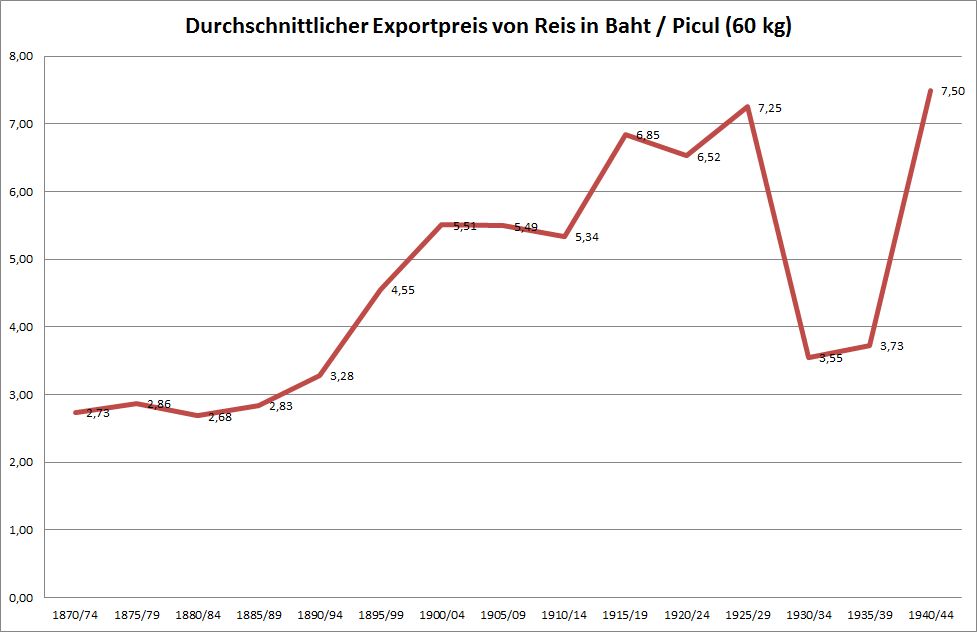
Abb.: Durchschnittlicher Exportpreis von Reis in Baht / Picul (60 kg), 1870
- 1944
[Datenquelle: Ingram (1971), S. 38]
1870 - 1950
Jährliches Durchschnitts-Einkommen in Geld (Baht) einer fünfköpfigen Reisbauern-Familie mit 20 Rai (3,2 Hektar) Land:
Jährliches Durchschnitts-Einkommen in Geld (Baht) einer fünfköpfigen Reisbauern-Familie mit 20 Rai (3,2 Hektar) Land, 1870 - 1950
[Datenquelle: Ingram (1971), S. 65]
1870
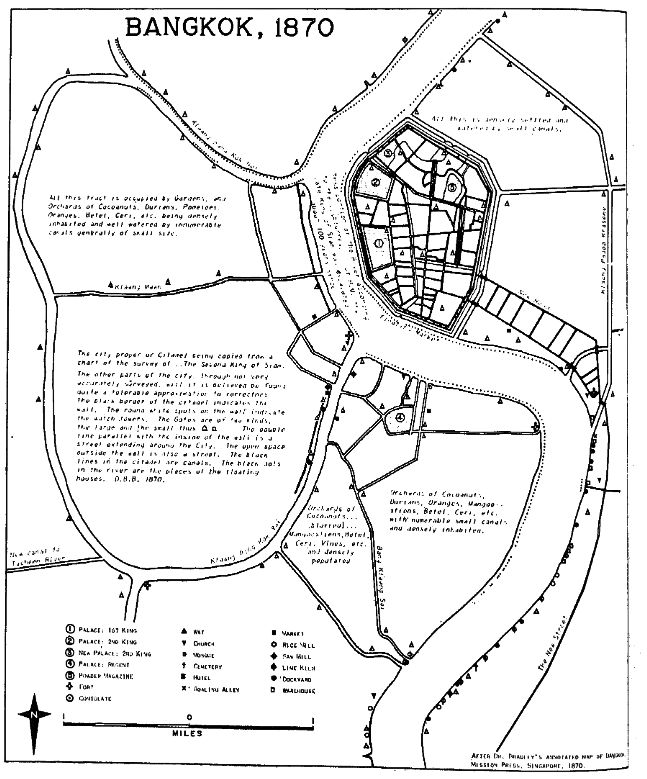
Abb.: Karte von Bangkok, 1870
[Bildquelle: Sternstein, Larry: Bangkok at the turn of the century
: Mongkut and Chulalongkorn entertain the West. -- In: Journal of the Siam
Society. -- 54,1 (1966). -- S. 58]
1870

Vollendung des Phra Pathom Chedi (พระปฐมเจดีย), das Rama IV. über den zerstörten Chedi von Nakhon Pathom (นครปฐม) bauen ließ.
Abb.: Lage des Phra Pathom Chedi (พระปฐมเจดีย)
[Bildquelle: OpenStreetMap. -- Creative Commons Lizenz (Namensnennung, share alike)]
Abb.: Phra Pathom Chedi (พระปฐมเจดีย), ca. 1925
[Bildquelel: Wikipedia. -- Public domain]
"Der Phra Pathom Chedi (Thai: พระปฐมเจดีย) ist mit 127 m der höchste buddhistische Chedi weltweit. Der Chedi steht in der Stadt Nakhon Pathom in Thailand. Geschichte
Der Name Phra Pathom Chedi bedeutet Heiliger Chedi des Anfangs. Die ersten schriftlichen Aufzeichnungen über diesen Chedi reichen bis ins Jahr 675, doch deuten archäologische Ausgrabungen darauf hin, dass bereits im 4. Jahrhundert ein erster Chedi errichtet worden war.
Nach der Eroberung des Landes durch die Khmer wurde der Chedi mit einem Prang überbaut, der später vom Dschungel bedeckt wurde. Die Ruine wurde im 19. Jahrhundert wieder entdeckt, als der spätere König Mongkut (Rama IV.) während seiner Zeit als Wandermönch durch die Wälder Nakhon Pathoms streifte. Nach seiner Krönung ordnete er an, hier eine neue und besonders wichtige buddhistische Stätte zu errichten. Nach 17 Baujahren wurde das Bauwerk 1870 unter seinem Nachfolger König Chulalongkorn (Rama V.) vollendet. Chulalongkorn ließ das Bauwerk später auch mit feinen chinesischen Ziegeln überziehen. Die Bevölkerung aus dem nahe gelegenen Nakhon Chai Si (นครชัยศรี) wurde in die neu errichtete Stadt um den Chedi herum angesiedelt."
[Quelle: http://de.wikipedia.org/wiki/Phra_Pathom_Chedi. -- Zugriff am 2012-04-28]
1870

Abb.: Mönche, 1870
1870/1871
Bildung der Königlichen Leibgarde (Royal Pages Body Guard) unter Phraya Surasakmontri (พระยาสุรศักดิ์มนตรี = Saeng Saeng-Xuto - เจิม แสง-ชูโต, 1851 - 1931) und Nay Ratchanatayanuhan (นายราชาณัตยานุหาร = Phon Bunnag - พร บุนนาค, 1849/50 - 1920)
Mitglieder der Leibgarde können nur Adlige werden. Sie erhalten je nach Leistung einen monatlichen Sold von 8, 10 bzw. 12 Baht.
Aus dem Reglement der Leibgarde:
"Article XXVII At daybreak, [soldiers are to] rise, wash and dress.
At 6.30 a.m. [they must be] seated at table for tea or coffee.
Tea or coffee over, they are to collect their guns and go out to training. They are to drill together.
At 9 a. m., training completed, they are to return to the mess to eat their breakfast ["morning rice"].
Breakfast over, they will sleep, occupy themselves or study as they wish.
At 2 p. m., they will go to mess for mid-day dinner.
At 3 p. m., they will prepare for training.
Training over, they will make ready to march in royal processions. If there is no procession, the troops are to march in rehearsal along pleasant roads.
At 7 p. m., they are to be seated at table for their supper.
Soldiers must behave in this way at all tines.
[You] officers are forbidden from allowing soldiers to wander about, eating secretly, eating whilst walking or eating with their hands. [Such behavior] results in lapses of personal etiquette and breaches the refined manners prescribed here. Should any soldier disregard this requirement, he must be removed from table by an officer and made to hold his plate. For two days he is to be observed to his shame by the soldiers regaining at the table. Then he is to be released from punishment."
[Übersetzung: Battye, Noel Alfred <1935 - >: The military, government, and society in Siam, 1868-1910 : politics and military reform during the reign of King Chulalongkorn. -- 1974. -- 575 S. -- Diss., Cornell Univ. -- S. 125]
1870
Um den Mangel an Rekruten zu beheben, wird in Klöstern gewaltsam rekrutiert.
1870
Als Vorbild zum Umgang mit den chinesischen Geheimgesellschaften dient die Garnison Fort Canning in Singapur: die ständige Präsenz von Polizei und Militär in den Straßen Singapurs beendet die chinesischen Bandenkämpfe.
Abb.: Lage von Fort Canning
[Bildquelle: Baedeker: Indien. -- 1914]
Abb.: Fort Canning, Singapur
[Bildquelle: Wikipedia. -- Public domain]
1870
Gründung der Indo-Siam Sugar Company. Sie ist ein Fehlschlag.
Abb.: Zuckerrohrfeld, Sop Prap (สบปราบ), 2012
[Bildquelle: Brian Hoffman. -- http://www.flickr.com/photos/34829087@N06/8448448353. -- Zugriff am 2013-12-07. -- Creative Commons Lizenz (Namensnennung, keine kommerzielle Nutzung, share alike)]
"When the export of sugar began to attract commercial attention, two attempts at improvement were made about 1867 and 1870. The first was a private venture of Sombatboribun [Phra Pasi Sombatboribun - พระภาษีสมบัติบริบูรณ์]; and the second was organized by a group called the Indo-Siam Sugar Company, to whom the Government gave 25,000 acres of land on the condition that the manufacture of sugar would be on a scale commensurate with the liberality of the concession. Siamese officials at the time told the American consul that they would make a similar concession to his nationals. But neither of these efforts met with the anticipated success, and after 1870 there was a marked decline in sugar exports. The main cause of this decline was the attitude of the factory owners towards the planters. As a rule the factory would buy the crop green at about Tcs. 24 a red, advancing a third of that sum in cash and paying the rest when the factory had sold its sugar. The factories would not allow the cane to be cut until it suited them; and this delayed planting operations, with the result that the cane deteriorated. Two further and increasingly important causes of the decline in this industry were the competition of Javanese sugar and the extension of rice cultivation."
[Quelle: Thompson, Virginia <1903 - 1990>: Thailand the new Siam. -- New York : Macmillan, 1941. -- S. 487f.]
1870

Abb.: Tanzaufführung, 1870
1870

Die Regierung schickt erstmals eine Gruppe von Schülern und Studierenden zur Weiterbildung nach Großbritannien. Unter ihnen ist Prinz Prisdang Jumsai (พระอง์คเจ้า ปฤษฎาง์ค ชุมสาย, 1851 - 1932).
Prinz Prisdang besucht:
- eine Privatschule in Streatham Common: Elementarunterricht, Drill
- St. Paul's School, Stony Stratford (6 Monate): Geographie, Geschichte, Physik, Mathematik. St. Pauls wurde 1863 von Reverend G. Sankey gegründet. Sie beschreibt sich 1864 so: "conducted on Church of England principles ... to be a place of religious and good secular education. The general course of instruction includes Latin, Greek , French, Mathematics, and the usual details of a sound English Education." (Quelle: http://www.mkheritage.co.uk/mkm/stonystratford/docs/fegan.html. -- Zugriff am 2015-03-05)
- Privatschule von Rev. La Touche, Shropshire (1 Jahr 4 Monate)
- King's College, University of London (3 Jahre): Applied Science Department
Abb.: Lage von Streatham Common
[Bildquelle: OpenStreetMap. -- Creative Commons Lizenz (Namensnennung, share alike)]
Abb.: Lage von Stony Stratford
[Bildquelle: OpenStreetMap. -- Creative Commons Lizenz (Namensnennung, share alike)]
Abb.: Inserat für St. Paul's School, Stony Stratford, 1864
Abb.: Lage von Shropshire
[Bildquelle: OpenStreetMap. -- Creative Commons Lizenz (Namensnennung, share alike)]
Abb.: Lage des King's College, London
[Bildquelle: OpenStreetMap. -- Creative Commons Lizenz (Namensnennung, share alike)]
Abb.: King's College, Kapelle, 2014
[Bildquelle: David Iliff . -- http://www.flickr.com/photos/diliff/13147157183/. -- Zugriff am 2015-03-03. -- Creative Commons Lizenz (Namensnennung, keine kommerzielle Nutzung, share alike)]
1870

Die Marine bestellt von Großbritannien sechs Kanonenboote.
1870
US-Missionar Samuel John Smith (1820-1909) veröffentlicht im Druck
สุนทรภู่ [Sunthorn Phu] <1786 - 1855>: พระอภัยมณี [Phra Aphai Mani]
Die Veröffentlichung ist ein großer finanzieller Erfolg. Deshalb veröffentlicht Smith in der Folgezeit weitere Werke Sunthorn Phu's. Smith spezialisiert sich auf Druckausgaben von Thai-Klassikern.
1870
Der US-Baptistenmissionar Dan Beach Bradley (1804 - 1873) besucht Phuket (ภูเก็ต). Er schreibt darüber:
Abb.: Lage von Junk Ceylon (Ujong Salan) /Phuket] (ภูเก็ต)
[Bildquelle: Scottish Geographical Magazine, 1886. -- Public domain]
"The island was, some few years ago, divided into two provinces, called Salang [Thalang] [ถลาง] and Poket [ภูเก็ต]. Before the division, the island consisted of only one province called Salang, the principle inhabitants of which were Malays, with a few Siamese, and they cultivated rice and caught fish sufficient for their own consumption. The Governor of the island was then Phra Phalat [the son of Lady Chan {ท่านผู้หญิงจัน, 1735 - 1793}], He was sent to Poket when it was only a fishing village and being an enterprising sort of man he determined to see what treasures were concealed beneath the soil and was so far successful as to find something which he thought would in a few years amply repay the outlay which he might make ... The Chinese soon flocked in numbers to Phuket and Phra Phalat furnished them with funds to commence work and the place prospered and grew apace." [Zitiert in: Mackay, Colin <1936 - >: A history of Phuket and the surrounding region. -- Bangkok : White Lotus, 2013. -- 438 S. : Ill. ; 25 cm. -- ISBN 978-974-480-195-1. -- S. 229]
"The Chinese soon flocked in numbers to Phuket [ภูเก็ต], P’ra Palat [พระปลัด] furnished them with funds to commence work and the place prospered and grew apace ... and now what was a paddy field is covered with brick houses and numerous population ... most of the buildings have been built by the raja [ราชา] [governor]. The revenues are farmed out the same as in Bangkok. Tongkah Bay [ทุ่งคา] is the port of Poket. A good road leads to the town which is 1.5 miles distant from the harbour master’s office and that is about two miles from the junk anchorage. The population of Phuket [town] consists of 25,000 Chinese, 300 Siamese, 200 Siamo-Malays, 200 British subjects and 200 Indians, Malays and other Europeans ... The Chinese are divided into different factions and are continually at variance with each other. These men during the south-west monsoon [the rainy season] find plenty of employment at the tin mines but during the northeast monsoon numbers of them are idle, being out of employment owing to the scarcity of water for washing the tin ... why this province should be rent by factions where there is room enough to spare for 25,000 in Salang [ถลาง / تلوڠ] is beyond my comprehension. Gambling predominates more than in Bangkok and is the principle cause of so much trouble in the island." [Zitiert in: Mackay, Colin <1936 - >: A history of Phuket and the surrounding region. -- Bangkok : White Lotus, 2013. -- 438 S. : Ill. ; 25 cm. -- ISBN 978-974-480-195-1. -- S. 310]
1870
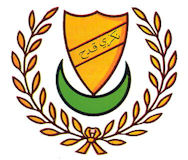
Sultan Ahmad Tajuddin Mukarram Shah von Kedah (قدح) weist Chinesen Land zu zum Anbau von Kaffee und Gewürznelken (Syzygium aromaticum)
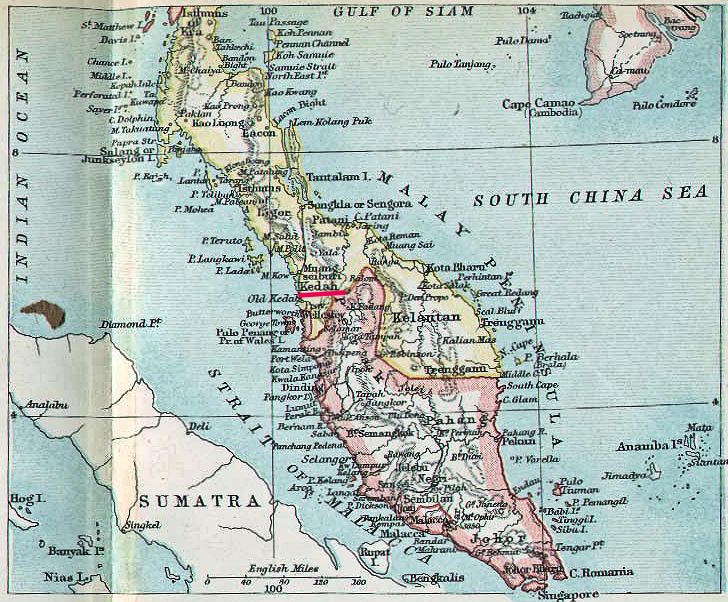
Abb.: Lage von Kedah (قدح)
[Bildquelle: Constables Hand Atlas of India, 1893. -- Pl. 59]
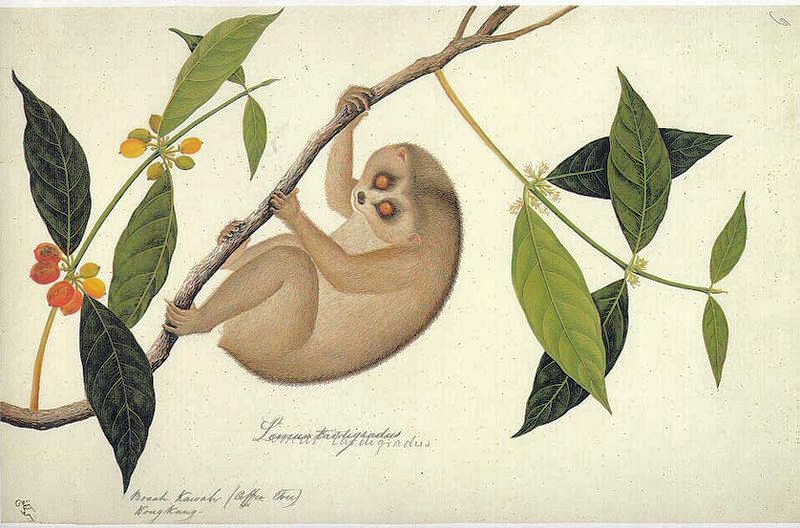
Abb.: Kaffepflanze, Malaya, 1819/23
[Bildquelle: Wikimedia. -- Public domain]
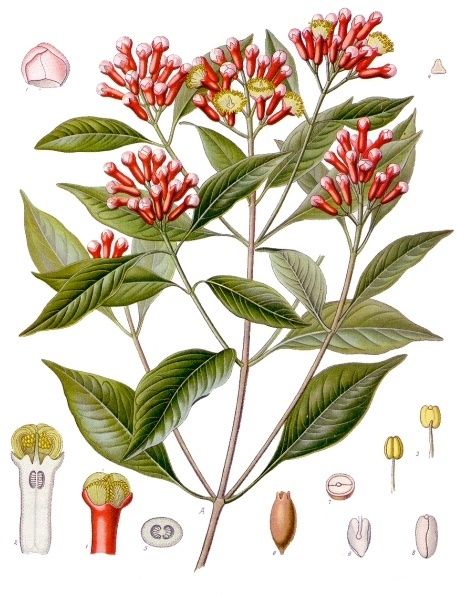
Abb.: Gewürznelke (Syzygium aromaticum)
[Bildquelle: Köhler's Medizinal-Pflanzen, 1897. -- Public domain]
1870
Aufnahme des regelmäßigen Dampfschiffverkehrs zwischen Amoy (廈門) und Singapur. Dies führt zur großen Einwanderung von Hokkien-Chinesen (福建话) in Südthailand
Abb.: Lage von Amoy (廈門) und Singapur
[Bildquelle: OpenStreetMap. -- Creative Commons Lizenz (Namensnennung, share alike)]
1870

Es erscheint
Bilbaut, Théophile: Le Canal de Suez et les intérêts nationaux : la Cochinchine française et le royaume de Cambodge. -- Paris : Challamel, 1870. - 135 S.
1870

Inbetriebnahme der Telegraphenlinie London-Teheran. Dort Anschluss an das indische Staatstelegrafennetz. In Betrieb bis 1931.
Abb.: Hauptrouten der britisch-indischen Telekommunikation bis 1913
[Bildquelle: Dr. Michael Wobring / Wikipedia. -- GNU FDLicense]
1870

Der englische Ingenieur William Froude (1810 - 1879) baut mit Unterstützung der britischen Admiralität in Torquay (England) das erste Versuchsbecken für Experimente mit Schiffsmodellen. Dadurch wird die Entwicklung des Schiffbaus sehr beschleunigt.
Abb.: Schiffsbau-Versuchsbecken, Washington Navy Yard, Washington, DC (USA), ca. 1900. Dies ist das erste solche Becken in den USA.
[Bildquelle: Wikipedia. -- Public domain]
1870-01-10

John D. Rockefeller(1839 - 1937) gründet in Ohio (USA) die Standard Oil Company. Sie wird in der Folgezeit einer der größten Konzerne der Welt.
Abb.: John D. Rockefeller
[Bildquelle: Puck 1901 / Wikipedia. -- Public domain]
1870-02-22
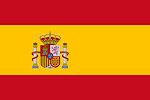
Unterzeichnung des Spanisch-Siamesischen Vertrags.
Abb.: Spanische Kolonien in Südostasien und Ozeanien: Philippinen, Marianen und Karolinen, 1858
[Bildquelle: Wikimedia. -- Public domain]
1870-03-09 - 1870-04-15


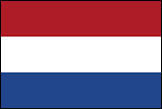
Der König besucht britisch Singapur und niederländisch Java (Batavia, Semarang)
Abb.: Lage von Singapur, Batavia und Semarang
[Bildquelle: Baedeker: Indien, 1914]
1870-04 - 1870-08


In den April, Mai, Juni und Augustnummern von Atlantic Monthly <Boston> erscheint als Fortsetzung:
Leonowens, Anna Harriette <1831 - 1915>: The English Governess at the Siamese Court : Being Recollections of Six Years in the Royal Palace at Bangkok
Anschließend erscheinen in Boston (Fields, Osgood & Co.), Philadelphia (Porter & Coates) und London (Trubner & Co.) Buchausgaben:
Leonowens, Anna Harriette <1831 - 1915>: The English Governess at the Siamese Court : Being Recollections of Six Years in the Royal Palace at Bangkok. -- Philadelphia: Porter and Coates, 1870. -- 322 S. : Ill.
Abb.: Titelblatt
Abb.: Speisung von Mönchen
[a.a.O., nach S. 186]

Rezension in Overland Monthly and Out West Magazine. -- vol. 6, no. 3 (March 1871). -- S. 293ff.
"The English Governess at the Siamese Court: Being Recollections of Six Years in the Royal Palace at Bangkok. By Anna Harriette Leonowens. with Illustrations from Photographs presented to the Author by the King of Siam. Boston: Fields, Osgood & Co. 1870. There are no longer any penetralia anywhere. The private life of the most sacred personages is turned inside out, and bookwrights and newspaper correspondents penetrate everywhere. If the Grand Lama of Thibet still secludes himself within the Snowy Mountains, 'tis but for a season. For curiosity of late has cunning grown, and at its own good pleasure spies out the secrecy of every life. This may be Byron adapted to a modern subject, but it is nevertheless true. After the New York newspapers have "interviewed" the Japanese Mikado, and have drawn pen-pictures (from the life) of the Brother of the Sun and Moon, who rules the Central Flowery Kingdom, there does not appear to be much of any thing left for the ubiquitous and unconquerable book-making observer. The mystery which has for ages surrounded the existence of Oriental potentates has been the last refuge of falsehood, fleeing from indomitable curiosity. Even this has gone at last -- rude hands having torn away the tantalizing curtains which concealed the dread arcana from the eyes of the profane world -- and sunlight has streamed in upon the astonished inmates, blinking and cowering in their nakedness among the gaudy shams of their languid existence.
Most remarkable of all these exposures is the simple and graphic story of the life which an English governess led for six years in the palace of the Supreme King of Siam. Who would have thought, years ago, when we read of the mysterious, gilded, jeweled palaces of Bangkok, the royal train of white elephants, the awe-inspiring paraphernalia of P'hra parawendt Maha Mongkut -- who would have thought that all these splendors would be uncovered for us, just as a new Asmodeus might take the roofs off the gilded temples and harems, and expose all the wretched contents? But this has been done, and Mrs. Leonowens, in her fresh, lively way, tells us of all she saw. And the sight is not satisfactory. Human nature in a pagan palace, burdened though it may be with a royal ceremonial and covered with jewels and silk attire, is a few shades weaker than elsewhere. The swelling domes, crusted with barbaric pearl and gold, worshiped at a distance by the awe-struck subjects of the mighty ruler, cover as much lying, hypocrisy, vice and tyranny as may have been found in the palaces of Le Grande Monarque in the days of the Montespans, the Maintenons, and the Cardinals Mazarin and De Retz. Poor humanity does not vary much, after all, whether we find it in a hovel or castle; and it is edifying to have the truism so often and abundantly fortified by evidence from the four corners of the globe.
The English governess at the Court of Siam had marvelous opportunities for seeing the whole domestic and interior life of royalty in Siam. An instructor of the King's children, she came to be on familiar terms with the august tyrant who holds the lives of a great nation in his hand. A woman, she was permitted to penetrate into the secret recesses of the harem, and could tell all that was fit to tell of the life of the multitudinous wives of the oriental despot. So we have all the minutia of the Siamese Court, not tediously drawn out, but graphically sketched by an observant woman, and charming from its novelty, if nothing more. There is, too, a touch of sadness in all she says of the poor women who languish out their lives in this splendid misery. The poor child-wife of the King, who sang a scrap of "There is a Happy Land, far, far away;" the concubine, beaten on the mouth with a slipper -- these, and all others like them, are the sombre shadows of the interior life of the royal abode. We close the book, heartily glad that we are not subjects of his Golden-Footed Majesty of Siam."
[Zitiert: http://womenshistory.about.com/od/leonowensanna/a/leonowens_egom.htm. -- Zugriff am 2015-05-12]
1870-04-25
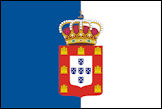
Der portugiesische Generalkonsul ertrinkt.
1870-05-28
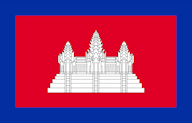
Auf Druck Frankreichs ernennt König Norodom I ( ព្រះបាទនរោត្តម) (1834 – 1904) von Kambodscha seinen Halbbruder, Prinz Sisowath (ព្រះបាទស៊ីសុវតិ្ថ) (1840 – 1927) zum obbareach (Vizekönig, uparāja, อุปราช)
1870-07
The Siam Repository:
Marking The People. The entire population of the Kingdom of Siam is divided off and assigned to particular nobleman, who become, what here is termed, the Government master.
The people thus portioned off are subject to their respective masters, who can compel them to serve, whenever the Government requires the execution of any particular Work from that master. The Siamese Government holds the Nobleman master responsible for all the individuals subject to him.
The wants of the Government are so numerous, that all artisans are serviceable to the
Government, and the requisition is for the particular labor that the men can best perform.All lads from the ages of 15 and upward are liable to be drafted and assigned, usually to the master or chief of the department to which the father was assigned.
In
these cases the lads are seized, driven to the marking office, and are marked on the right or left wrist as their master may be of the right or left rank. This mark is definite showing who his master is and to what kind of Government work he is liable.This is one of the most burdensome requisitions of the Siamese Government on its citizens. Of the marked men, some must give their entire time to the Government. In these cases they usually receive a nominal salary, upon which alone it would be impossible for them to subsist.
Some are required to give half their time to the Government. Some of these receive a pittance of a salary, others none. They work fifteen days consecutively and are allowed the next fifteen days to engage in other labor for self support. Others again are required to serve the Government three months out of twelve. These, unless they are petty officers, receive no compensation from the Government. No matter what distance these poor Government servants reside, they must find their own means of conveyance to Bangkok, or to the place where the work is required of them. They must provide and cook their own food, and furnish themselves with cloths and sleeping gear, which consists of a mat, a hard pillow and in the rainy season when mosquitos are numerous of mosquito curtains.
The Government has no other concern than getting out of them its work during the full amount of time for which they are assessed. It not unfrequently happens that they are required to give extra service.
Some criminals, who are convicted for grave offences, not sufficient to condemn them to death, are marked on the forehead, or branded and are compelled to serve the Government, as paddy grinders, or grass cutters for the Royal elephants and horses.
Every Province in the Kingdom marks its men, and is responsible to the general Government for its quota of wok or money according to the assessment of its marked men.
There are those in the provinces and remote localities who may not be obtainable for personal services, in these oases they must pay the equivalent in money, as per valuation of their master, who meets the government demand upon them by substituting the labor of others.
There is another class of persons, who are indebted to others and are used by the creditor in lieu of the interest of the principal they owe. The creditors have these persons marked as their slaves. These persons are exempt from personal services, but the creditor pays the Government on their account, regularly 1
½ ticals per annum.There are some classes of women, who are required to do government work, as well as men. Under the late reign some of these were known as Amazons, others, make fancy silk cloths and others, fancy work.
Of all people thus subject to the government demand by marking and registration, each must either render personal service or pay what his or her particular master will exact as a money equivalent. There is no exemption from this condition. Often times widowed mothers and fatherless children have entailed upon them heavy debts which they cannot possibly cancel, and become hopelessly slaves through the father’s negligence or knavery, in consequence of nonfulfilment of these Government claims.
There are these who cannot for love nor money obtain personal exemption. It is with the utmost difficulty that such are able to earn enough to support themselves and their families even if, through extreme leniency, time is sometimes allowed for self support.
The summary of the government requisition is, some must serve-the Government all the time, to this class there is no exemption and they receive a very insufficient annual salary.
Some serve 9 months in the year. Some six months, the majority three months. The three month men receive no salary, provide their own conveyance to the place of work, and provision and cloths themselves. There is a large class who pay from 9 to 12 ticals per year, in lieu of
all government claims upon them. These are favored ones. Some pay 26 ticals per annum in lieu of personal services. This is a very heavy tax upon the population.In addition to this requisition of personal services. The produce of the soil, the produce of the rivers, lakes, seas, manufactures, and industry are all and each taxed. Spirits, gambling and opium very rigorously so.
The Chinese who visit Siam, are considered as being subjects of the local laws of Siam, and a source of revenue is derived from them in the shape of a
TRIENNIAL TAX.
Once in every three years the Siamese Government allows some one to purchase the right of collecting this tax.
When the right to collect has been obtained. The purchaser of the right allows his agents in all parts of the Kingdom to establish themselves at given locations. For a given season, the Chinese are permitted to come voluntarily to these places and pay each their 4½ ticals. When they thus come a string is attached to the left wrist, tied and the knot is fastened with k'rang, a stiff gum, which is stamped.
Then a certificate is made out giving the name, height, and a specific identification of the person. Having paid his tax, had fastened the string to his left wrist, and received his identification paper, our tailed celestial may go and traffic where he lists, and when challenged must show his wrist badge and written certificate. If these are beyond suspicion, he meets no more annoyance, it remains for him only to pay the usual taxes levied on what he produces for sale, on his trees, if an orchard owner, on his cultivated land, if he cultivates, on his fishings, if a fish catcher, on his timber and lumber, if a wood cutter, on his stalls, stores, boats, if a trader and on any article he may manufacture.
After a specified time, those who have not voluntarily paid their triennial tax, are liable to be arrested, and then they must pay an additional sum
for their arrest, over and above the 1 1/2 ticals tax.The children and grand children of Chinese who have migrated to Siam, are usually placed under a government master, and when thus placed are considered by the Siamese laws in every sense Siamese.
There is just now special effort being made to create an army. Proclamations, have been issued to prevail upon young unmarked men from 15 years old and upward to present themselves for this branch of government service.
Those who like this prospect are voluntarily being marked for this service. Others not liking a soldier's life are concealing themselves in hopes they may escape impressment and eventually be marked for some other department of Government service, that is, the department to which their father belonged.
These are the exactions of the Siamese Government which the people generally dread and were flight possible, the bulk of the common people would make their escape.
To prevent escape, the mouths of all rivers leading to the sea, the mountain passes affording passages to foreign countries are guarded by companies of petty officials whose duty it is to prevent all who are subject to the laws of Siam from going beyond their limits.
As the laws of Siam, requiring the registration of Natives born in the Kingdom, and the designation to a particular master, and the Triennial taxation of Chinese, not legitimately subject to the Western Treaty powers, is now being enforced we shall probably see re-enacted by these liable natives the many and sometimes amusing subterfuges to which they adroitly resort, to evade if possible the execution of this very burdensome law.
If possible, Chinese, Malays, Barman, and Peguans, will sedulously attempt to secure registration in some of the Treaty power Consulates. Should they dupe the Consul and effect their registration, their exemption from the Siamese Registration and Triennial Tax becomes all but certain.
Falling in this artifice they will apply for situations, as personal servants, hoping thereby to be allowed to wear a badge, hatband, or carry a paddle having perhaps the name of the employer inscribed thereon.
Failing in this they insinuate themselves as relatives to certain appendages of some of the Foreign establishments, and by Siamese phraseology are without impropriety allowed to claim relationship, more or less remote and thus unavoidably and in spite of the honest intentions of their Foreign masters, by the Siamese language recognised relatives, they secure more or less protection.
These are favorite resorts as these relations, do not generally require abstinence from what rigid religionists denominate evils.
As a dernier resort however, they will come to the Foreign missionary, and with deeply studied semblance of penitence, piety and conversion will ask the fervently zealous teacher for baptism, and recognition as church members, and it does sometimes happen that these truly devoted men are grossly imposed upon. And men and women are sometimes notoriously set forth in foreign religious periodicals as pre-eminent examples of fervent piety, and when justly, perhaps, punished by their irritated, and to a certain extent cheated masters, they are triumphantly lauded, and believed to be by conscientiously religious people abroad as brilliant examples
of martyrdom..Such cases of imposition, we trust, will each year grow less and less, where the best of men are working and will work for the salvation of
the unenlightened pagan, because Jesus their Savior requires the labor, though it may apparently seem to be a prodigal waste of money, precious time, and pre-eminent energy and ability."[Quelle: The Siam repository : containing a summary of Asiatic intelligence. -- Vol 2, No. 2 (July 1870). -- S. 362 - 364]
1870-07-15

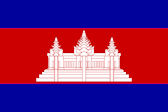
Unterzeichnung des Article aditionnel au traité du 15 Juillet 1867 mit Frankreich über die Nutzung des großen Sees (Tonlé Sap - ទន្លេសាប) in Kambodscha.
Abb.: Lage des Tonlé Sap (ទន្លេសាប)
[Bildquelle: OpenStreetMap. -- Creative Commons Lizenz (Namensnennung, share alike)]
Abb.: Tonlé Sap (ទន្លេសាប)
[Bildquelle: ©Google earth. -- Zugriff am 2012-04-10]
1870-07-16
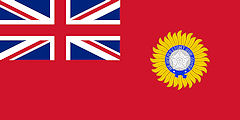
James Talboys Wheeler (1824 - 1897), Sekretär des Chief Commissioner of British Burma, beschwert sich über die Gesetzlosigkeit an der britisch-nordsiamesischen Grenze:
"Not only are the commercial interests of British merchants largely involved, but the lives and property of British subjects are seriously affected by the continued disturbances on this frontier, which the presence of a considerable body of police can alone repel." [Zitiert in: Manich Jumsai [มานิจ ชุมสาย] <1908 - 2009>: History of Anglo-Thai relations. -- 6. ed. -- Bangkok : Chalermnit, 2000. -- 494 S. : Ill. ; 21 cm. -- S. 187]
1870-07-18

Das Oberhaupt der Katholiken Siams kann unfehlbare Lehren von sich geben: Das 1. Vatikanische Konzil nimmt die dogmatische Konstitution Pastor Aeternus an.
Abb.: Christus erleuchtet seinen Stellvertreter auf Erden: 1. Vatikanisches Konzil
1870-09
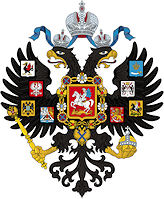
Der russische Anarchist Michail Alexandrowitsch Bakunin (Михаил Александрович Бакунин) (1814 - 1876) veröffentlicht "Lettres a un Français sur la crise actuelle". Darin fordert er die "propagande par le fait" (Propaganda durch die Tat), was dann oft durch terroristische Anschläge geschieht. "Die 90er-Jahre des 19. Jahrhunderts wurden als ein „Jahrzehnt der Bomben“ bezeichnet. Anschläge mit Dynamit – einer ganz neuen Erfindung – in rascher Folge richteten sich gegen Monarchen, Präsidenten, Minister, Polizeichefs oder -beamte und Richter, die Anarchisten verurteilt hatten. Andere trafen offizielle Gebäude." (Wikipedia). Thailand wird ein Hort für Terroristen werden.
Abb.: Antianarchistische Karikatur, USA, 1919-07-05
[Bildquelle: Wikimedia. -- Public domain]
1870-09-04

Léon Gambetta (1838 - 1882) und Jules Favre (1809 - 1880) rufen in Frankreich die Republik aus (Dritte Republik - Troisième République française - bis 1940). Ab jetzt bleibt Frankreich Republik.
Abb.: "He devoured France with activity": Léon Gambetta / von Charles Auguste Loye
[Bildquelle: Vanity Fair 1872-10-19 / Wikimedia. -- Public domain]
Abb.: Jules Favre / von André Gill (1840 - 1885)
[Bildquelle: La Lune 1867-03-31 / Wikimedia. -- Public domain]
ausführlich: http://www.payer.de/thailandchronik/ressourcen.htm
Phongpaichit, Pasuk <ผาสุก พงษ์ไพจิตร, 1946 - > ; Baker, Chris <1948 - >: Thailand : economy and politics. -- Selangor : Oxford Univ. Pr., 1995. -- 449 S. ; 23 cm. -- ISBN 983-56-0024-4. -- Beste Geschichte des modernen Thailand.
Ingram, James C.: Economic change in Thailand 1850 - 1870. -- Stanford : Stanford Univ. Pr., 1971. -- 352 S. ; 23 cm. -- "A new edition of Economic change in Thailand since 1850 with two new chapters on developments since 1950". -- Grundlegend.
Akira, Suehiro [末廣昭] <1951 - >: Capital accumulation in Thailand 1855 - 1985. -- Tokyo : Centre for East Asian Cultural Studies, ©1989. -- 427 S. ; 23 cm. -- ISBN 4896561058. -- Grundlegend.
Skinner, William <1925 - 2008>: Chinese society in Thailand : an analytical history. -- Ithaca, NY : Cornell Univ. Press, 1957. -- 459 S. ; 24 cm. -- Grundlegend.
Mitchell, B. R. (Brian R.): International historical statistics : Africa and Asia. -- London : Macmillan, 1982. -- 761 S. ; 28 cm. -- ISBN 0-333-3163-0
Smyth, H. Warington (Herbert Warington) <1867-1943>: Five years in Siam : from 1891 to 1896. -- London : Murray, 1898. -- 2 Bde. : Ill ; cm.
ศกดา ศิริพันธุ์ = Sakda Siripant: พระบาทสมเด็จพระจุลจอมเกล้าเจ้าอยู่หัว พระบิดาแห่งการถ่ายภาพไทย = H.M. King Chulalongkorn : the father of Thai photography. -- กรุงเทพๆ : ด่านสุทธา, 2555 = 2012. -- 354 S. : Ill. ; 30 cm. -- ISBN 978-616-305-569-9
Lavery, Brian: Schiffe : 5000 Jahre Seefahrt. -- London [u. a.] : DK, 2005. -- S. 184. -- Originaltitel: Ship : 5000 years of marine adventure (2004)